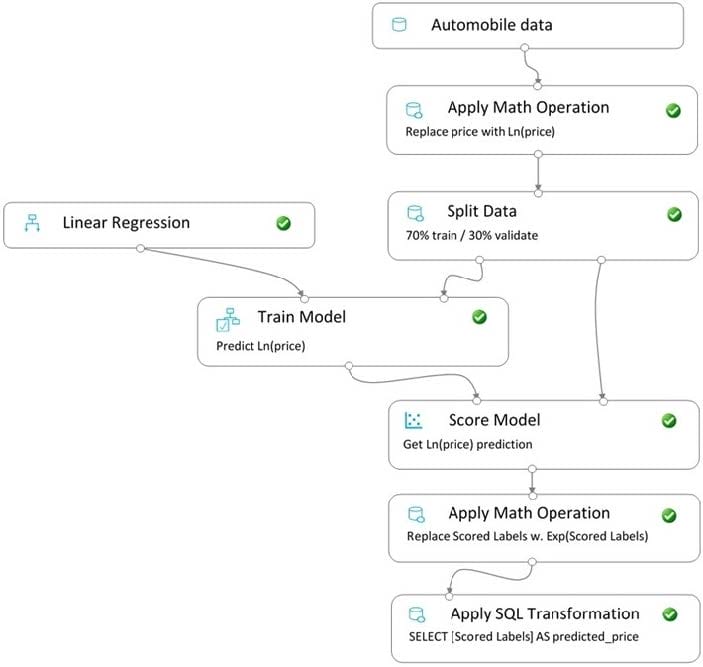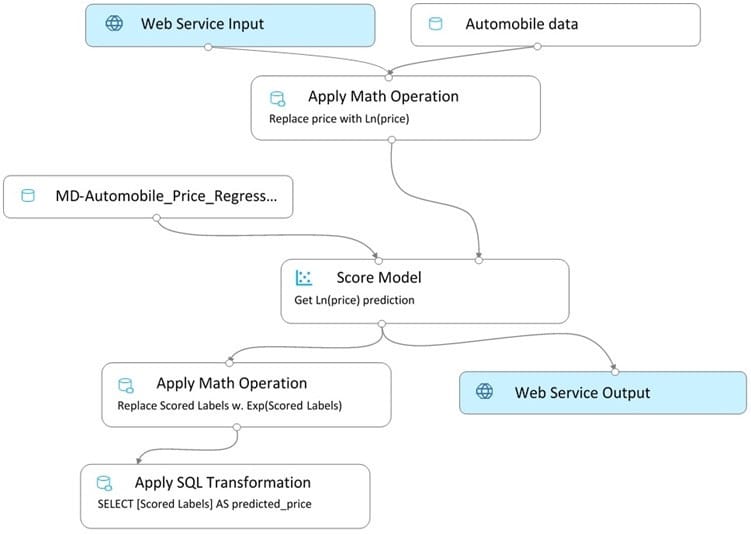Exam Details
Exam Code
:DP-100Exam Name
:Designing and Implementing a Data Science Solution on AzureCertification
:Microsoft CertificationsVendor
:MicrosoftTotal Questions
:564 Q&AsLast Updated
:Jul 05, 2025
Microsoft Microsoft Certifications DP-100 Questions & Answers
-
Question 301:
You run an experiment that uses an AutoMLConfig class to define an automated machine learning task with a maximum of ten model training iterations. The task will attempt to find the best performing model based on a metric named accuracy.
You submit the experiment with the following code:

You need to create Python code that returns the best model that is generated by the automated machine learning task. Which code segment should you use?
A. best_model = automl_run.get_details()
B. best_model = automl_run.get_metrics()
C. best_model = automl_run.get_file_names()[1]
D. best_model = automl_run.get_output()[1]
-
Question 302:
Note: This question is part of a series of questions that present the same scenario. Each question in the series contains a unique solution that might meet the stated goals. Some question sets might have more than one correct solution, while
others might not have a correct solution.
After you answer a question in this section, you will NOT be able to return to it. As a result, these questions will not appear in the review screen.
You create a model to forecast weather conditions based on historical data.
You need to create a pipeline that runs a processing script to load data from a datastore and pass the processed data to a machine learning model training script.
Solution: Run the following code:

Does the solution meet the goal?
A. Yes
B. No
-
Question 303:
You use Azure Machine Learning designer to create a training pipeline for a regression model.
You need to prepare the pipeline for deployment as an endpoint that generates predictions asynchronously for a dataset of input data values.
What should you do?
A. Clone the training pipeline.
B. Create a batch inference pipeline from the training pipeline.
C. Create a real-time inference pipeline from the training pipeline.
D. Replace the dataset in the training pipeline with an Enter Data Manually module.
-
Question 304:
You retrain an existing model.
You need to register the new version of a model while keeping the current version of the model in the registry.
What should you do?
A. Register a model with a different name from the existing model and a custom property named version with the value 2.
B. Register the model with the same name as the existing model.
C. Save the new model in the default datastore with the same name as the existing model. Do not register the new model.
D. Delete the existing model and register the new one with the same name.
-
Question 305:
You create a machine learning model by using the Azure Machine Learning designer. You publish the model as a real-time service on an Azure Kubernetes Service (AKS) inference compute cluster. You make no change to the deployed
endpoint configuration.
You need to provide application developers with the information they need to consume the endpoint.
Which two values should you provide to application developers? Each correct answer presents part of the solution.
NOTE: Each correct selection is worth one point.
A. The name of the AKS cluster where the endpoint is hosted.
B. The name of the inference pipeline for the endpoint.
C. The URL of the endpoint.
D. The run ID of the inference pipeline experiment for the endpoint.
E. The key for the endpoint.
-
Question 306:
You create a pipeline in designer to train a model that predicts automobile prices.
Because of non-linear relationships in the data, the pipeline calculates the natural log (Ln) of the prices in the training data, trains a model to predict this natural log of price value, and then calculates the exponential of the scored label to get
the predicted price.
The training pipeline is shown in the exhibit. (Click the Training pipeline tab.)
Training pipeline

You create a real-time inference pipeline from the training pipeline, as shown in the exhibit. (Click the Real-time pipeline tab.) Real-time pipeline

You need to modify the inference pipeline to ensure that the web service returns the exponential of the scored label as the predicted automobile price and that client applications are not required to include a price value in the input values.
Which three modifications must you make to the inference pipeline? Each correct answer presents part of the solution.
NOTE: Each correct selection is worth one point.
A. Connect the output of the Apply SQL Transformation to the Web Service Output module.
B. Replace the Web Service Input module with a data input that does not include the price column.
C. Add a Select Columns module before the Score Model module to select all columns other than price.
D. Replace the training dataset module with a data input that does not include the price column.
E. Remove the Apply Math Operation module that replaces price with its natural log from the data flow.
F. Remove the Apply SQL Transformation module from the data flow.
-
Question 307:
You train a model and register it in your Azure Machine Learning workspace. You are ready to deploy the model as a real-time web service.
You deploy the model to an Azure Kubernetes Service (AKS) inference cluster, but the deployment fails because an error occurs when the service runs the entry script that is associated with the model deployment.
You need to debug the error by iteratively modifying the code and reloading the service, without requiring a re-deployment of the service for each code update.
What should you do?
A. Modify the AKS service deployment configuration to enable application insights and re-deploy to AKS.
B. Create an Azure Container Instances (ACI) web service deployment configuration and deploy the model on ACI.
C. Add a breakpoint to the first line of the entry script and redeploy the service to AKS.
D. Create a local web service deployment configuration and deploy the model to a local Docker container.
E. Register a new version of the model and update the entry script to load the new version of the model from its registered path.
-
Question 308:
You are creating a classification model for a banking company to identify possible instances of credit card fraud. You plan to create the model in Azure Machine Learning by using automated machine learning. The training dataset that you are using is highly unbalanced.
You need to evaluate the classification model. Which primary metric should you use?
A. normalized_mean_absolute_error
B. AUC_weighted
C. accuracy
D. normalized_root_mean_squared_error
E. spearman_correlation
-
Question 309:
You create a multi-class image classification deep learning model that uses a set of labeled images. You create a script file named train.py that uses the PyTorch 1.3 framework to train the model.
You must run the script by using an estimator. The code must not require any additional Python libraries to be installed in the environment for the estimator. The time required for model training must be minimized.
You need to define the estimator that will be used to run the script.
Which estimator type should you use?
A. TensorFlow
B. PyTorch
C. SKLearn
D. Estimator
-
Question 310:
Note: This question is part of a series of questions that present the same scenario. Each question in the series contains a unique solution that might meet the stated goals. Some question sets might have more than one correct solution, while
others might not have a correct solution.
After you answer a question in this section, you will NOT be able to return to it. As a result, these questions will not appear in the review screen.
You have a Python script named train.py in a local folder named scripts. The script trains a regression model by using scikit-learn. The script includes code to load a training data file which is also located in the scripts folder.
You must run the script as an Azure ML experiment on a compute cluster named aml-compute.
You need to configure the run to ensure that the environment includes the required packages for model training. You have instantiated a variable named aml-compute that references the target compute cluster.
Solution: Run the following code:

Does the solution meet the goal?
A. Yes
B. No
Related Exams:
62-193
Technology Literacy for Educators70-243
Administering and Deploying System Center 2012 Configuration Manager70-355
Universal Windows Platform – App Data, Services, and Coding Patterns77-420
Excel 201377-427
Excel 2013 Expert Part One77-725
Word 2016 Core Document Creation, Collaboration and Communication77-726
Word 2016 Expert Creating Documents for Effective Communication77-727
Excel 2016 Core Data Analysis, Manipulation, and Presentation77-728
Excel 2016 Expert: Interpreting Data for Insights77-731
Outlook 2016 Core Communication, Collaboration and Email Skills
Tips on How to Prepare for the Exams
Nowadays, the certification exams become more and more important and required by more and more enterprises when applying for a job. But how to prepare for the exam effectively? How to prepare for the exam in a short time with less efforts? How to get a ideal result and how to find the most reliable resources? Here on Vcedump.com, you will find all the answers. Vcedump.com provide not only Microsoft exam questions, answers and explanations but also complete assistance on your exam preparation and certification application. If you are confused on your DP-100 exam preparations and Microsoft certification application, do not hesitate to visit our Vcedump.com to find your solutions here.